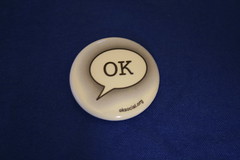
Image by eyeliam via Flickr
Creative vs. Marketing. It’s always a tense relationship. In fact, Smashing Magazine calls it “oil and water.”
Here’s what happens. Management has an idea to promote something.
Creative works hard to make something beautiful.
Marketing stalks in with changes, different strategies and second-guessing.
Everybody gets mad. It doesn’t have to happen. Creative vs. marketing doesn’t have to be a fight. Just follow a few simple rules, and everyone can win. And, the office will be a happier place.
Marketing’s job
Write a creative brief (click the link for a free template) that explains clearly what the target market is, the objective, the primary message, the mood/tone of the piece, etc. It should reflect what the audience wants and what will appeal to them. If that means making the brochure blue, make it blue. It’s a lot easier for the creative folks to do their jobs if they have clear direction as to what you want.
Creative’s job
First read the brief. Ask questions about what the client wants. If something isn’t clear, ask for clarification or an explanation. The request for a blue brochure may seem silly, but marketing may have data showing the company’s customers respond better to blue.
Make the piece interesting, memorable, and appealing to the target audience. To follow the brief, create a design that meets the needs of the client and understand that sometimes a design or part of one might be axed if it doesn’t.
Depending on what it is, there may be usability issues too. A pretty website that nobody can figure out how to use won’t make much money.
The market reaction is what counts. Even if you have to make the logo bigger.
Listen, listen, listen
This goes for both marketing and creative. If marketing wants something that won’t print properly, it’s creative’s job to tell them (and marketing’s job to listen to that advice). If marketing wants all blue, ask why if you need to, and then listen to the answer.
Back in the corporate world, I always got along well with the creatives. I listened a lot. And then I made friends (my secret tactic was a big bowl of candy on my desk). Also, they knew I had an art background, had used the software, and had a good idea of what it could and couldn’t do (and how long it would take).
Earn the other “side’s” respect. And show you respect them too. No robots needed.




